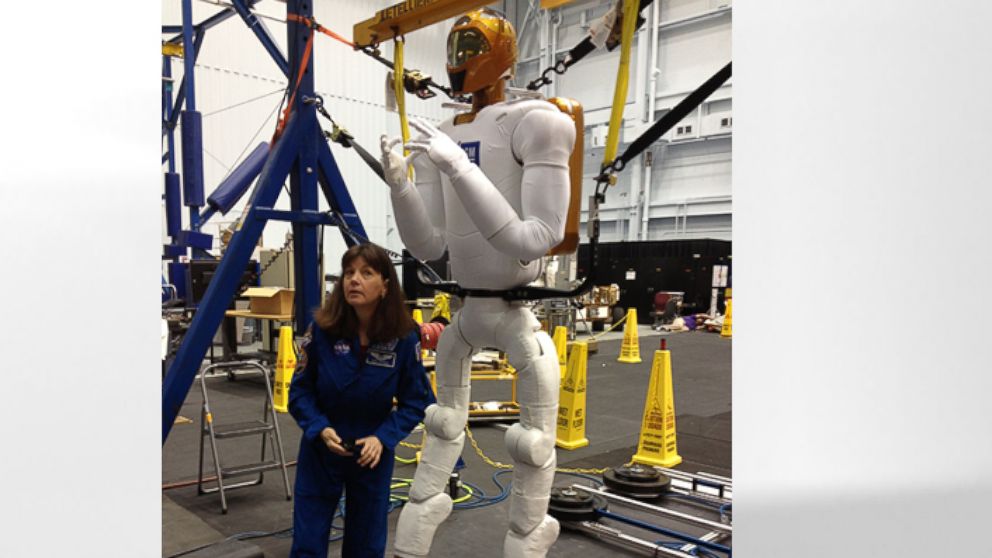NASA's Biggest Astronaut: Robonaut to Take Giant Leap Into Space With New Legs
Nov. 8, 2013 — -- Think of Robonaut as the strong, silent type.
He wasn't programmed to talk but he's diligently working his sign language. He offered on Twitter to play the role of George Clooney's sidekick if there is a "Gravity" prequel. And his tweets show a sense of humor -- in one he told the Mars Curiosity rover that he wasn't into long-distance relationships.
Robonaut is poised to take on a bigger role on the International Space Station when he gets legs early next year. ABC News got a sneak preview of Robonaut with his legs, and he is a big guy. He is now eight feet tall and weighs about 500 pounds.
Astronaut Cady Coleman unpacked Robonaut when he arrived onboard the ISS in 2011. Engineers at NASA jokingly call her Robonaut's big sister. But what arrived then was a torso with a head and arms. Coleman said she's now excited about the expanded potential of robots in orbit.
"There is no question in my mind that bringing robots outside and having them do spacewalks would be a great use of robots in space. A spacewalk takes a lot of consumables, we breathe, we have to check out the spacesuits," Coleman told ABC News. "We have to be triple sure that everything is right because we don't want to lose anyone on a spacewalk."
Robonaut's legs will allow him to move around the space station by himself, but Coleman said his size does concern astronauts.
"When he is floating free around the cabin, what if someone kicks him? That is still several hundred pounds, kaboom, slamming into some experiment, some person, some piece of the space station," she explained. "That is dangerous, so we need Robonaut to move around safely by himself, so he can work by himself."
"That is not an option for a human, but totally reasonable for the robot."
Rob Ambrose heads the robotics program at the Johnson Space Center in Houston. He envisions just this scenario for Robonaut -- a member of the crew who can hold his breath indefinitely outside.
"It can go outside for a long time, and even stay outside. If we asked that crew member to stay outside for a couple of weeks that is not an option for a human, but totally reasonable for the robot," Ambrose told ABC News.
But don't expect Robonaut to be walking on the moon anytime soon. NASA moves slowly with new technology. Robonaut is a 50-year project and designers are 17 years into Robonaut's development. When his legs arrive and are attached, he won't immediately leap into action. The crew will follow a careful process of attaching them and testing them before Robonaut starts moving around the space station.
What will Robonaut do with his new legs? Like a toddler taking his first steps, Coleman said Robonaut will need to learn how to move first. "His legs are going to be really, really long. He has to be able to stretch through the hatches on the space station between modules," she said. "He is going to walk more like an antelope than take little steps."
Robonaut won't be the only bot in space. He has a little friend, the Japanese robot Kirobo, which will be springing into action more often now that Japanese astronaut Koichi Wakata has arrived at the ISS. Kirobo is chatty compared to Robonaut, saying things like "Good morning to everyone on Earth."
A chatty robot has a place in space, said Coleman. "Our job is to figure out how to interact with robots to get the most out of them," she explained. "I tend to think you are going to do that if you like them. ... I think it is better to get inside its head and give it a little personality."
But that might not be Robonaut's future if Ambrose has his way. Ambrose said he hopes robots of the future won't be a smarty-pants like Star Trek's Commander Data.
"The first science fiction movie I really remember was 'Silent Running,'" he said. "It was about a set of robots that helped tend gardens in space and they had a little personality -- Huey and Dewey."




